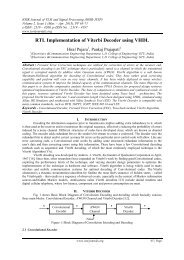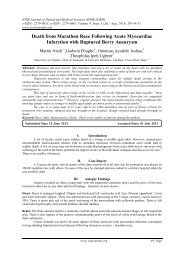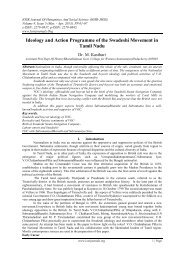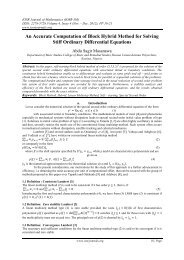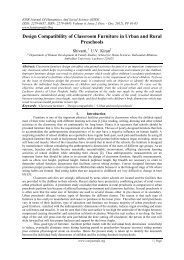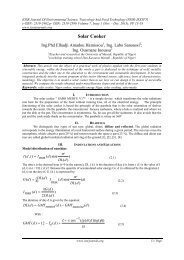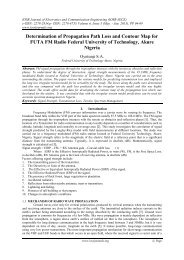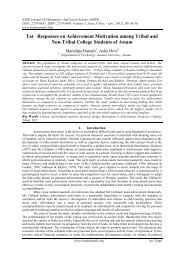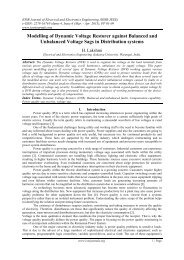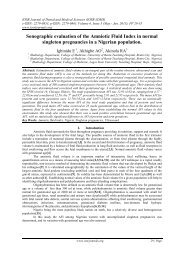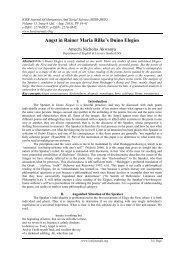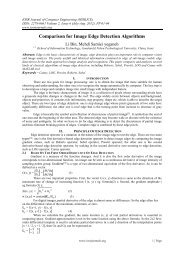Initial Conquest of India by Turks and Their Slaves - IOSR
Initial Conquest of India by Turks and Their Slaves - IOSR
Initial Conquest of India by Turks and Their Slaves - IOSR
You also want an ePaper? Increase the reach of your titles
YUMPU automatically turns print PDFs into web optimized ePapers that Google loves.
<strong>Initial</strong> <strong>Conquest</strong> Of <strong>India</strong> By <strong>Turks</strong> And <strong>Their</strong> <strong>Slaves</strong><br />
others who joined it, a community <strong>of</strong> „descent through tradition‟ <strong>and</strong> through recognition <strong>of</strong> the political<br />
leadership <strong>of</strong> a charismatic clan.<br />
Stein,M.A. (ed),Kalhana‟s Rajtarangini (Delhi, 1960),IV,p.131-64;Wink Andre,Al-Hind: The Making<br />
<strong>of</strong> the Indo-Islamic World,I.Early Medieval <strong>India</strong> <strong>and</strong> the Expansion <strong>of</strong> Islam,7th-11th centuries<br />
(Leiden,1990).p.239-243.[Hereafter Al-Hind,I]<br />
Al-Biruni,Kitab al-Hind,p.486<br />
Cf.Harishch<strong>and</strong>ra,Bharat-durdasha,Act 3,in: R.S.Mc Gregor, Hindi Literature from its Beginnings to<br />
the Nineteenth Century (Wiesbaden, 1984),p.3.<br />
Other terms that are used include Tajika <strong>and</strong> Yavana (Ionians).On the term mleccha, see T.R.Sharma,<br />
Personal <strong>and</strong> Geographical Names in the Gupta Inscriptions (Delhi, 1978),p.149-52. For the use <strong>of</strong> Tajika or<br />
Tayi, see J.Newman, „Islam in the Buddhist Kalacakra Tantra‟ (Paper presented to the 1989 Annual Meeting <strong>of</strong><br />
the American Academy <strong>of</strong> Religions, Annaheim,CA.1989), <strong>and</strong> D.C.Sircar, Studies in the Geography <strong>of</strong> Ancient<br />
<strong>and</strong> Medieval <strong>India</strong> (Delhi,1971),p.126-7,131. For „Shaka Princes‟ , see Epigraphia Indica, Arabic <strong>and</strong> Persian<br />
Supplement,1913-14 (Calcutta, 1917; reprint Delhi, 1987),p.35-45. For Mudgalas,see G.Buhler, The<br />
Jagaducharita <strong>of</strong> Sarvanada: a Historical Romance from Gujrat (Vienna,1892),p.19. For Yavanas, see Sircar,<br />
Studies in Geography,p.396; Epigraphia Indica,III, p. 338-9; A.K. Narain , The Indo-Greeks<br />
(Delhi,1980),p.165-9.<br />
C.E.Bosworth,’The Imperial Policy <strong>of</strong> the Early Ghaznavids’,Islamic Studies 1 (1962), part 3, p.49-82,<br />
represented in his Medieval History.For a brief survey <strong>of</strong> the dynasty, see B.Spuler, „Ghaznavids’ , Ch.Pellat et<br />
al.(eds.), The Encyclopaedia <strong>of</strong> Islam,new edition (Leiden,1954- in progress). The st<strong>and</strong>ard works are Bosworth,<br />
The Ghaznavids. <strong>Their</strong> Empire in Afghanistan <strong>and</strong> Eastern Iran 994:1040, 2 nd edition (Beirut, 1973); idem, The<br />
Later Ghaznavids,Splendour <strong>and</strong> Decay: The Dynasty in Afghanistan <strong>and</strong> Northern <strong>India</strong> 1040-1186<br />
(Eidenburgh,1977).<br />
Al-Hind, I, p.126.<br />
Al-Utbi,Tarikh al-Yamini (Delhi, 1847),p.20-21,23[Hereafter Al-Utbi];Al-Utbi, Tarikh al-Yamini: Persian<br />
translation <strong>by</strong> Jurbadqani(1206 AD) (Tehran,1334 H),p.33-35[Hereafter Jurbadqani]; Tarikh-i-Farishta<br />
(Lucknow,1864),p.18-19; Alami.A, Conquetes de Mahmud al- Ghaznawi d’apres le Kitab al Yamini d’Utbi,2<br />
vols (Doctorat d’Etat,Paris,III,1989).p.93-9. [Hereafter Alami.]<br />
Al-Utbi,p.26; Jurbadqani,p.38-39,152; Tarikh- i- Farishta (Lucknow,1864),p.19-20;Al- Hind,I,p. 126,216.<br />
Al-Utbi,p.161-3; Jurbadqani,p.138-9; Tarikh-i-Farishta (Lucknow,1864),p.23;M.Nazim (ed.),Zayn al-Akhbar <strong>of</strong><br />
Gardizi (Berlin,1928),p.62.[Hereafter M.Nazim]<br />
M.Nazim ,p.63,65; Alami,I,p.400-3, 405-16; Al-Utbi,p.179; Jurbadqani,p.155-6; Tarikh-i-Farishta<br />
(Lucknow,1864),p.24; Al-Hind,I ,p.126.<br />
Tarikh-i-Farishta (Lucknow,1864),p.26-27; 1 Al-Utbi,p.278-86; Jurbadqani,p.187-8; M.Nazim ,p.69; Alami, II<br />
p.454-57.<br />
„Tawassut dyar al-hind‟,‟waista mamalik-i-hind‟ (Al-Utbi,p.303;Jurbadqani,p.198.)<br />
Al-Utbi,p.329-36; Jurbadqani,p.210-2; Tarikh-i-Farishta (Lucknow,1864),p.28; M.Nazim,p.72; Alami,II<br />
,p.500-17.<br />
Al-Utbi,p.336-8; Jurbadqani,p.213-4; Tarikh-i-Farishta (Lucknow,1864),p.27-28;<br />
Sachau,E.C.(trans.),Alberuni‟s <strong>India</strong> (New Delhi,1983),p.117; M.Nazim,p.71-72; Alami,p.484-91.<br />
Al-Utbi,p.395-400; Jurbadqani,p.242-4; Tarikh-i-Farishta (Lucknow,1864),p.29; M.Nazim,p.75-76; Alami,II<br />
,p.525-8.<br />
Jurbadqani,p.244-5; Al-Utbi,p.400-1; Tarikh-i-Farishta (Lucknow,1864),p.29; Al-Hind,I,p.286,290;<br />
Alami,II,p.528-32.<br />
Al-Utbi,p.415; Jurbadqani,p.251-2; C.J.Tornberg (ed.),Ibn al-Athir, Al-Kamil fi l-Tarikh, 12 vols (Leiden,1853-<br />
1869),VII,p.301[Hereafter C.J.Tornberg]; Tarikh-i-Farishta (Lucknow,1864),p.31; Al-Hind,I,p.286;<br />
Alami,II,p.547-58.<br />
M.Nazim,p.78-79; Tarikh-i-Farishta (Lucknow,1864),p.31; Alami,II,p.562-6.<br />
M.Nazim,p.79-80; Tarikh-i-Farishta (Lucknow,1864),p.31; Alami,II,p.566-71.<br />
Al-Hind,I,p.68,185,218,307; Tarikh-i-Farishta (Lucknow,1864),p.32-35;C.J.Tornberg,IX,p.241-2,345-6;<br />
M.Nazim,p.87-88;Alami,II,p.571-85.<br />
Gazetteer <strong>of</strong> the province <strong>of</strong> Oudh.3 vols (Lucknow <strong>and</strong> Allahabad,1877-78),III,p.487<br />
Gazetteer <strong>of</strong> Oudh,I,p.112.<br />
Cf.T.Mahmood,`The Dargah <strong>of</strong> Sayyid Salar Masud Ghazi in Bahraich:Legend,Tradition <strong>and</strong> Reality’,in: Ch.<br />
Troll (ed.),Muslim Shrines in <strong>India</strong> (New Delhi,1984).<br />
W.H.Morley (ed.),Tarikh-i-Baihaqi (Calcutta,1862),p.323-9,495-8,500-38.<br />
Al-Hind,II,p.126.<br />
www.iosrjournals.org<br />
8 | Page



